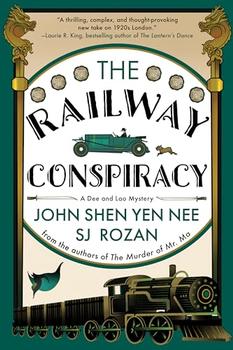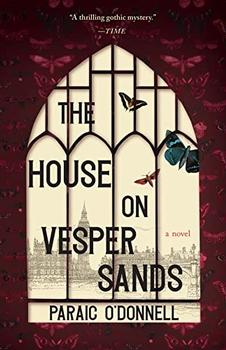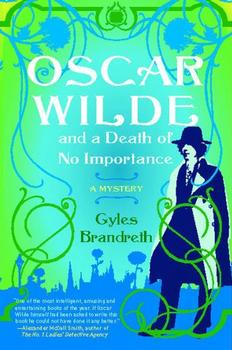Summary | Excerpt | Reviews | Beyond the book | Read-Alikes | Genres & Themes | Author Bio

A Dee and Lao Mystery
by John Shen Yen Nee, S.J. RozanAt the end of The Murder of Mr. Ma, the first book in S.J. Rozan and John Shen Yen Nee's Dee and Lao historical mystery series, Judge Dee Ren Jie has departed for China, leaving behind his friend, Lao She, to resume his career as a professor at the University of London. Book two, The Railway Conspiracy, has Dee returning to the city some months later as a representative of China's Nationalist party. Reunited, the pair set about investigating the theft of an ancient Chinese artifact—but as the plot thickens and the body count increases, it becomes clear there's much more at stake than the missing antique. Dee and Lao are joined in their endeavors by two characters they met during their previous adventure: shopkeeper and kung fu master Sergeant Hoong, and Jimmy Fingers, a (possibly) reformed pickpocket.
Many have compared Dee and Lao to Sir Arthur Conan Doyle's Sherlock Holmes and Dr. Watson: Dee, like Holmes, is a savant, with extraordinary physical and observational skills; Lao, like Dr. Watson, is his well-intentioned and loyal sidekick, often clueless and a bit bumbling, who narrates their adventures. And although Rozan and Nee's books are set in the 1920s—a little later than Doyle's—the London atmosphere feels remarkably similar, both in its daily bustle and its dark, danger-filled nights.
But that's not to say the pair are carbon copies of Holmes and Watson. The two men are fleshed-out, individual characters, with lives outside of their partnership. Dee supports China's Nationalists while Lao is an avowed Communist; Dee is an atheist and Lao is a Christian; Dee is more culturally Chinese, while Lao, who lives in England, prefers some aspects of British culture. And because of vivid and well-drawn supporting characters like Hoong and Jimmy, as well as new characters who are added to the recurring cast by the end of the book, the world feels broader than Doyle's does.
While The Murder of Mr. Ma was concerned with social issues faced by people of Chinese descent in London during the era, like difficulty finding housing and employment, this second novel is more concerned with the politics of China. The characters do certainly face racial prejudice, but unlike in the first novel, it's not central to the plot. Instead, much of the book revolves around China's internal struggles at the time—namely, the rise of both the Chinese Nationalist Party and the Chinese Communist Party and the conflicts between the two groups. The authors describe the debate in compelling terms, and make it easy for those not familiar with China's history to follow the issues.
One of the most impressive aspects of the series is how much historical fact underlies the plot. The Railway Conspiracy was a slow read for me, not because it wasn't a page turner (it definitely is) but because I had to compulsively verify information in the narrative. Yes, I learned, there really was a Palaseum Theatre in London owned by a Mr. Ben Hur (formerly a boxer named Henry Ben Solomon). There was also a London Necropolis Railway that operated for the sole purpose of conveying corpses and mourners from London to a large cemetery to the north. Even Dee and Lao are based on real-life figures (Di Renjie of the Tang and Wu Zhou Dynasties, and 20th century novelist Lao She, respectively). The list goes on; historical fiction fans will absolutely rejoice in all the tiny details the authors include.
And readers who don't necessarily revel in historical detail will likely still enjoy the action sequences. There are at least five multi-page kung fu battles that are relayed with cinematic clarity:
"Isaki rolled into the crouching posture of an iaijutsu stance. In one swift action, he drew his katana from its scabbard and swept a one-stroke killing slash. Hoong sidestepped the flashing sword; no sooner had he than Isaki, almost faster than I could follow, swung the blade a second time. Hoong bent back almost double to avoid this cut…I saw Hoong shift his legs…and catch the katana in mid-third-strike, flat between his massive palms. He twisted his body and his arms and, with a grunt, snapped the blade in two."
These action sequences can be a double-edged sword, though (pun intended). Sometimes they seem a bit gratuitous; other times, too fantastical. The comic book atmosphere is reinforced by Dee's propensity to dress up as the legendary Spring-heeled Jack (see Beyond the Book) to intimidate others or disguise his identity; there's even one vignette that calls to mind a scene from The Incredible Hulk. These passages are amusing, but they distract from the truly fine mystery into which they're inserted.
The Railway Conspiracy can be read as a standalone novel, but I highly recommend starting with the first book in the series, which explains how the various partnerships were formed, provides a fascinating backstory for Dee, and is every bit as entertaining.
![]() This review
first ran in the April 9, 2025
issue of BookBrowse Recommends.
This review
first ran in the April 9, 2025
issue of BookBrowse Recommends.

If you liked The Railway Conspiracy, try these:

by Paraic O'Donnell
Published 2022
With all the wit of a Jane Austen novel, and a case as beguiling as any in Sherlock Holmes' casebook, Paraic O'Donnell introduces a detective duo for the ages, and slowly unlocks the secrets of a startling Victorian mystery.

Oscar Wilde and a Death of No Importance
by Gyles Brandreth
Published 2008
Lovers of historical mystery will relish this chilling Victorian tale based on real events and cloaked in authenticity. Best of all, it casts British literature's most fascinating and controversial figure as the lead sleuth. (UK title: Oscar Wilde and the Candlelight Murders). Published in the USA simultaneously in hardcover and paperback.
Your guide toexceptional books
BookBrowse seeks out and recommends the best in contemporary fiction and nonfiction—books that not only engage and entertain but also deepen our understanding of ourselves and the world around us.